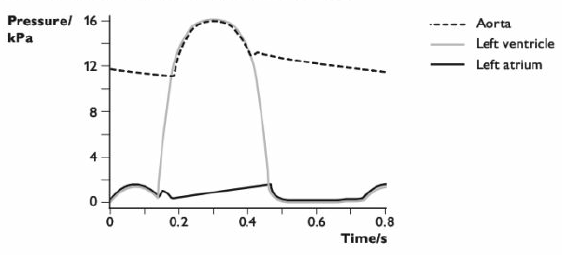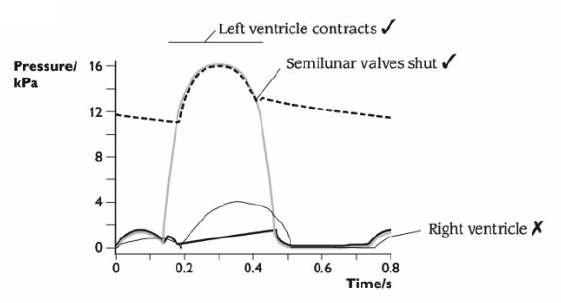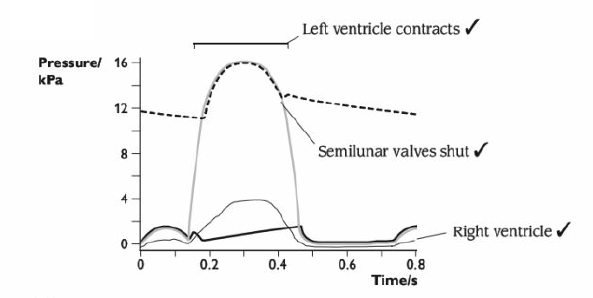Biology
- #82 Question 5
The diagram below shows a small part of a human lung as it appears through a microscope. (a) Name the type of blood vessel in which the red blood cell is present. (1 mark)(b) Describe and explain two ways in which the structure of the alveoli, shown...
- #80 Question 3
(a) The diagrams show a cell in various stages ofthe mitotic cell cycle. Name the stage represented by each diagram, and arrange them in the correct sequence. (b) Describe the role of spindle microtubules in mitosis. (3 marks) (c) The graph below shows...
- #78 Question 1
(a) The diagram shows a small part of a cell, as seen using an electron microscope. (i) Name the parts labelled A to D. (2 marks) (ii) Describe how part B is involved in the formation of extracellular...
- #46 The Heart
The mammalian heart is a double pump: - The right side pumps deoxygenated blood at low pressure to the lungs. - The oxygenated blood then returns to the left side of the heart in the pulmonary vein.- The left side pumps oxygenated blood...
- # 44 The Circulatory System - Blood Vessels
The mammalian circulatory system is a closed double circulation, consisting of a heart, blood vessels and blood. The heart produces high pressure --> blood moves through the vessels by mass flow. The mammalian...
Biology
#83 Question 6
The diagram below shows pressure changes in the left atrium and left ventricle of
the heart and the aorta during the cardiac cycle.

(a) Calculate how many heart beats there will be in one minute.
(c) After the blood leaves the heart, it passes into the arteries. The blood pressure gradually reduces and becomes more steady as the blood passes through the arteries. Explain what causes this reduction and steadying of the blood pressure.
Candidate A
(a) 1 cycle in 0.75 seconds ü so in 60 seconds there will be 60 x 0.75 û - 45 beats
* The student has read the length of one cycle correctly, but the calculation is wrong. 1/2
(b) (i)

* Correct. 1/1
(ii) The valves shut when the ventricle starts to relax . ü
* Correct as far as it goes, but it needs to give more information in order to get the second mark. 1/2
(iii) See diagram.
* Correct. 1/1
(iv) See diagram
* Partly correct. The pressure in the right ventricle is correctly shown as less than that in the left ventricle, but it should be contracting and relaxing at exactly the same times as the left ventricle. 1/2
(c) The pressure gets less as the blood gets further away from the heart. ü The muscle in the walls of the arteries contracts û and relaxes to push the blood along, and it does this in between heart beats so the pulse gets evened out.
* The first statement is correct, but does not really tell us any more than is in the question. However, it is not correct that the muscles in the artery wall contract and relax to push the blood along. 1/2
Candidate B
(a) 60/0.75ü = 80 beats per minute .ü
* Correct. 2/2
(b) (i)

* Correct. 1/1
(ii) They close when the pressure of the blood inside the arteries is higher than inside the ventricles ü - the blood therefore pushes down on the valves and makes them shut. ü
* Correct. 2/2
(iii) Seediagram.
* Correct. 1/1
(iv) Seediagram.
* Correct. 2/2
(c) As the blood is forced into the artery as the ventricle contracts, ü it pushes outwards on the artery wall, making the elastic tissue stretch . ü In between heart beats, the pressure of the blood inside the artery falls, and the elastic tissue recoils . üSo the wall keeps expanding and springing back. When it springs back it pushes on the blood in between üheart beats, so this levels up the pressure changes.
* This answer explains very well why the blood pressure levels out. However, it does not mention the overall fall in blood pressure. All the same, this is a good answer which gets full marks. 2/2
the heart and the aorta during the cardiac cycle.

(a) Calculate how many heart beats there will be in one minute.
(2 marks)
(b) (i) On the diagram, indicate the point at which the semilunar valves in the aorta snap shut.(1 marks)
(ii) Explain what causes the semilunar valves to shut at this point in the cardiac cycle.(2 marks)
(iii) On the diagram, indicate the period when the left ventricle is contracting.(1 mark)
(iv) On the diagram, draw a line to show the changes in pressure in the right ventricle.(2 marks)
(c) After the blood leaves the heart, it passes into the arteries. The blood pressure gradually reduces and becomes more steady as the blood passes through the arteries. Explain what causes this reduction and steadying of the blood pressure.
(2 marks)
(Total 10 marks)
(a) 1 cycle in 0.75 seconds ü so in 60 seconds there will be 60 x 0.75 û - 45 beats
* The student has read the length of one cycle correctly, but the calculation is wrong. 1/2
(b) (i)

* Correct. 1/1
(ii) The valves shut when the ventricle starts to relax . ü
* Correct as far as it goes, but it needs to give more information in order to get the second mark. 1/2
(iii) See diagram.
* Correct. 1/1
(iv) See diagram
* Partly correct. The pressure in the right ventricle is correctly shown as less than that in the left ventricle, but it should be contracting and relaxing at exactly the same times as the left ventricle. 1/2
(c) The pressure gets less as the blood gets further away from the heart. ü The muscle in the walls of the arteries contracts û and relaxes to push the blood along, and it does this in between heart beats so the pulse gets evened out.
* The first statement is correct, but does not really tell us any more than is in the question. However, it is not correct that the muscles in the artery wall contract and relax to push the blood along. 1/2
Candidate B
(a) 60/0.75ü = 80 beats per minute .ü
* Correct. 2/2
(b) (i)

* Correct. 1/1
(ii) They close when the pressure of the blood inside the arteries is higher than inside the ventricles ü - the blood therefore pushes down on the valves and makes them shut. ü
* Correct. 2/2
(iii) Seediagram.
* Correct. 1/1
* Correct. 2/2
(c) As the blood is forced into the artery as the ventricle contracts, ü it pushes outwards on the artery wall, making the elastic tissue stretch . ü In between heart beats, the pressure of the blood inside the artery falls, and the elastic tissue recoils . üSo the wall keeps expanding and springing back. When it springs back it pushes on the blood in between üheart beats, so this levels up the pressure changes.
* This answer explains very well why the blood pressure levels out. However, it does not mention the overall fall in blood pressure. All the same, this is a good answer which gets full marks. 2/2
- #82 Question 5
The diagram below shows a small part of a human lung as it appears through a microscope. (a) Name the type of blood vessel in which the red blood cell is present. (1 mark)(b) Describe and explain two ways in which the structure of the alveoli, shown...
- #80 Question 3
(a) The diagrams show a cell in various stages ofthe mitotic cell cycle. Name the stage represented by each diagram, and arrange them in the correct sequence. (b) Describe the role of spindle microtubules in mitosis. (3 marks) (c) The graph below shows...
- #78 Question 1
(a) The diagram shows a small part of a cell, as seen using an electron microscope. (i) Name the parts labelled A to D. (2 marks) (ii) Describe how part B is involved in the formation of extracellular...
- #46 The Heart
The mammalian heart is a double pump: - The right side pumps deoxygenated blood at low pressure to the lungs. - The oxygenated blood then returns to the left side of the heart in the pulmonary vein.- The left side pumps oxygenated blood...
- # 44 The Circulatory System - Blood Vessels
The mammalian circulatory system is a closed double circulation, consisting of a heart, blood vessels and blood. The heart produces high pressure --> blood moves through the vessels by mass flow. The mammalian...
